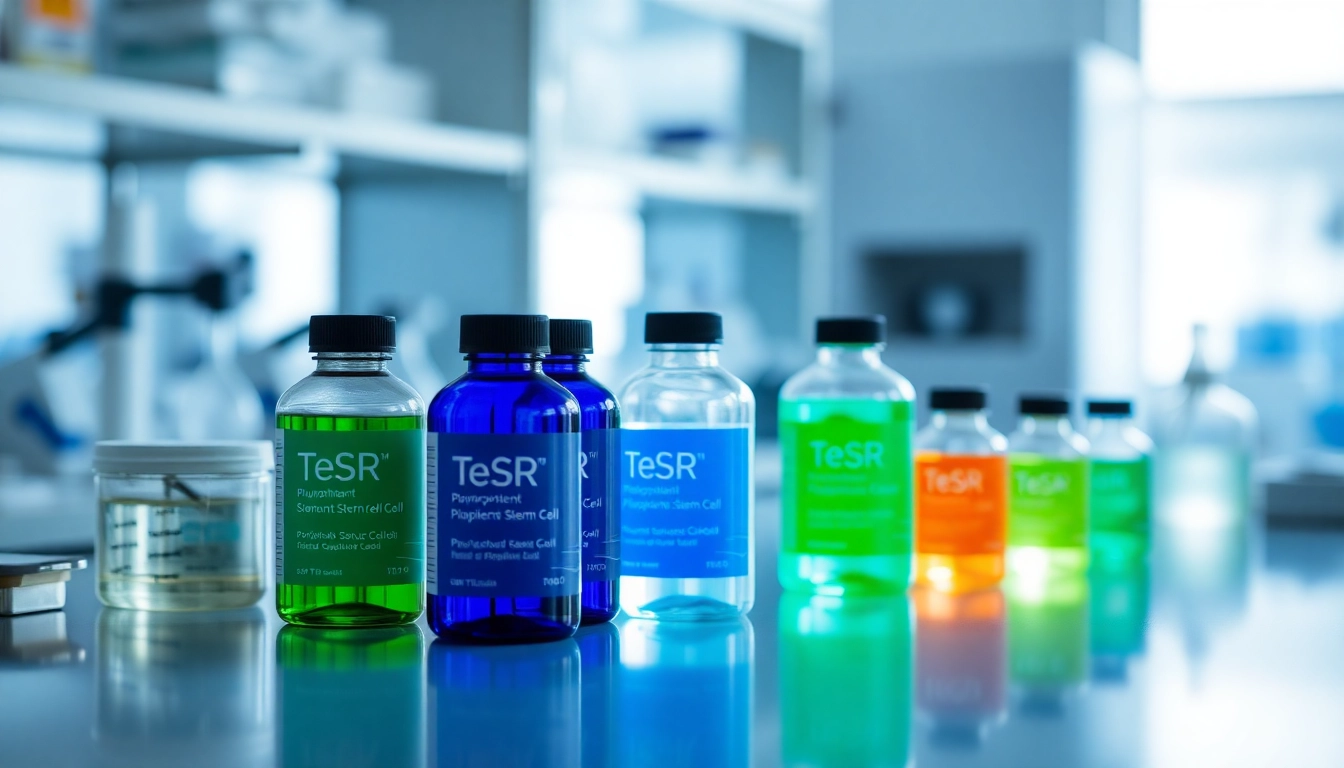Understanding the TeSR™ Media Family
Introduction to Feeder-Free Pluripotent Stem Cell Culture
The TeSR™ media family represents a significant advancement in the cultivation of human pluripotent stem cells (hPSCs). By utilizing a feeder-free culture system, researchers can effectively cultivate embryonic stem cells (ES) and induced pluripotent stem cells (iPS) without the complications and variability introduced by feeder layers. Feeder-free systems reduce the risk of contamination and allow for a more controlled environment that is crucial for the maintenance and differentiation of pluripotent stem cells. This liquid media approach simplifies the workflow, enhances cell quality, and provides reproducible results.
TeSR™ media is a product of rigorous scientific innovation, being rooted in formulations developed by Dr. James Thomson and his colleagues. These formulations have been adapted to ensure that they support the unique requirements of hPSCs, allowing for a standardized method to derive, maintain, and differentiate these cells effectively. For more detailed information about the complete range of TeSR™ media and their applications, refer to the official site all check.
Key Features of TeSR™ Media
The TeSR™ media family incorporates several key features that distinguish it from traditional culture methods. Firstly, the media are designed to be completely defined, which eliminates the ambiguity surrounding the variability associated with serum or other undefined supplements.
- Defined Composition: TeSR™ media are formulated with precisely defined components, allowing researchers to know what is being administered to the cells, which increases experimental reproducibility.
- Feeder-Free Environment: This system negates the complications of feeder layers, providing a more sterile and controlled setting that is crucial for hPSC cultivation.
- Enhanced Cell Viability: Enhanced buffering systems help maintain pH stability, which is crucial for maintaining high cell viability over extended periods.
- Flexibility in Applications: TeSR™ media support a variety of applications, from cell maintenance and expansion to differentiation into various cell types.
- Regulatory Compliance: Formulated under stringent cGMP conditions, these media are suitable for both basic and translational research.
Comparative Analysis of TeSR™ Media Options
The TeSR™ family offers a range of products tailored to various aspects of hPSC research. Key formulations include:
- mTeSR™1: The first commercially available feeder-free medium designed for the maintenance of human ES cells, widely recognized for its publication footprint.
- mTeSR™ Plus: A refined version of mTeSR™1 with improved buffering capabilities, allowing for extended media change intervals while maintaining cell quality.
- TeSR™-E8™: A low-protein maintenance medium developed to simplify the culturing process while ensuring essential components are included.
- TeSR™-AOF: An animal origin-free medium designed to enhance safety in clinical applications by eliminating the risk of zoonotic disease transmission.
- mFreSR™: A specific formulation for cryopreservation, ensuring long-term viability of hPSCs during storage.
Benefits of Using TeSR™ for hPSC Maintenance
How Feeder-Free Media Enhances Cell Quality
The shift towards feeder-free media such as TeSR™ has proven vital for enhancing cell quality. By minimizing the influence of extraneous growth factors and contaminants associated with feeder layers, researchers can maintain a stable environment for the cells. The predefined formulation in TeSR™ media significantly reduces batch-to-batch variability, making it easier to replicate results, a key concern in cellular research.
Moreover, with enhanced buffering capacities, TeSR™ contributors manage pH levels more effectively during culture, mitigating acidification that can adversely affect cell growth and differentiation.
Supporting Reprogramming and Differentiation
TeSR™ media plays a pivotal role not only in maintaining pluripotent stem cells but also in facilitating their reprogramming and differentiation into specific cell types. For example:
- ReproTeSR™: Developed for reprogramming fibroblasts into iPSCs, it provides the foundation required for effective conversion.
- TeSR™-E5 and TeSR™-E6: These media support differentiation into specialized cell types, adding versatility to the research applications.
- Specific Differentiation Kits: Accompanying differentiation kits such as the Erythroid Progenitor and CD34+ Progenitor Reprogramming Kits offer structured pathways towards generating defined cell populations.
Stability and Consistency Across Batches
One of the hallmark features of the TeSR™ media family is the commitment to stability and consistency. The adherence to Good Manufacturing Practices (cGMP) ensures that each batch is rigorously tested for quality, providing assurance to researchers that they receive a product that meets the highest standards. This consistency is paramount, as it minimizes variations that could affect experimental outcomes.
Choosing the Right TeSR™ Media for Your Research
Interactive Product Finder and Recommendations
Selecting the appropriate media for hPSC work can significantly impact the efficiency and outcomes of your experiments. The TeSR™ family provides an interactive product finder that aids researchers in determining the best media options suited for their specific applications.
Factors to Consider When Selecting Media
When choosing the right TeSR™ media, several factors should be taken into account:
- Purpose of Research: Identify whether the focus is on maintenance, reprogramming, differentiation, or cryopreservation.
- Cell Type: Some media are optimized for specific cell lines; understanding your cell line’s requirements aids in selecting the most effective media.
- Regulatory Concerns: If working towards clinical applications, choosing animal-origin free media would be advantageous for safety and compliance.
- Experimental Conditions: Consider laboratory conditions including temperature, potential contaminants, and whether weekend media changes are feasible.
Applications in Human ES and iPS Cell Culturing
The applications of TeSR™ media in the realm of hPSC research are vast. Studies utilizing these media have shown improvements in cell morphology, proliferation rates, and differentiation potential. It would be pertinent to examine how these media stack up in various studies and how they could benefit specific research needs.
Challenges and Solutions in hPSC Cultivation
Identifying Common Limitations in Cell Culture
Despite the numerous advantages offered by feeder-free culture systems like TeSR™, there are challenges that researchers routinely face:
- Variability: While the controlled environment reduces variability, factors such as metabolic waste and sensitivity to pH fluctuations can still pose challenges.
- Cell Line Specificity: Different cell lines may respond variably to media formulations, necessitating customized approaches for optimal results.
- Scaling Up: Transitioning from small-scale laboratory conditions to larger bioreactor systems can often introduce unforeseen complications.
Addressing Variability and Ensuring Reproducibility
Addressing variability involves understanding the specific needs of the cell lines and ensuring that environmental conditions remain stable. One approach is systematic monitoring of pH, glucose concentrations, and waste metabolites which can significantly impact cell cultures. Moreover, implementing rigorous training protocols for laboratory personnel can help standardize procedures that ensure reproducible results.
Quality Control Measures for Optimal Outcomes
Quality control is integral to ensuring that hPSCs maintain genomic integrity and pluripotency. Techniques such as karyotyping, gene expression profiling, and functional assays for pluripotency should be standard practice in laboratories utilizing TeSR™ media. Regular assessments and validations further safeguard against discrepancies that could undermine research findings.
Future Directions in Pluripotent Stem Cell Research
Innovations in TeSR™ Media Formulations
Ongoing research and development continue to enhance the TeSR™ media formulations. Innovations may include the incorporation of novel growth factors, cytokines, and regulatory molecules to further enhance the functionality and versatility of the media.
Furthermore, expanding the range of specialized differentiation media will play a crucial role in advancing research applications, particularly for regenerative medicine.
Regulatory Considerations and Compliance
As the regulatory landscape for stem cell research evolves, compliance with cGMP and appropriate regulatory standards is critical for researchers. The TeSR™ media family is already designed with these considerations in mind, which will aid laboratories in navigating the complex landscape of cellular therapies.
Emerging Applications and Research Trends
The future of hPSC research is promising, with emerging trends pointing towards the integration of pluripotent stem cells in personalized medicine, drug testing, and tissue engineering. Expanding applications could see hPSCs utilized in toxicological assessments, disease modeling, and as potential treatments for various ailments.



